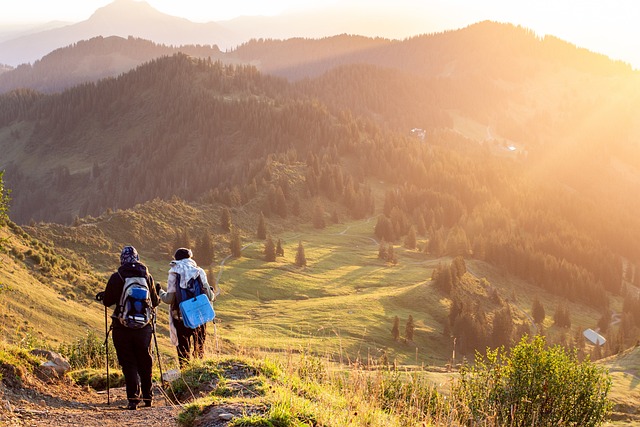Hiking is a fantastic way to explore the great outdoors, stay active, and connect with nature. However, as enjoyable and rewarding as this activity can be, it’s essential to follow proper hiking practices to ensure both safety and enjoyment. Whether you’re a seasoned hiker or a beginner, it’s crucial to avoid common mistakes that can lead to accidents, environmental harm, or even ruin your overall experience.
In this comprehensive guide, I’ll dive deep into the most common pitfalls to avoid while hiking. I’ll discuss inadequate planning, disrespecting the environment, ignoring hiking etiquette, poor nutrition and hydration, unsafe navigation, inappropriate clothing and footwear, and the lack of emergency preparedness. By understanding these potential issues, you’ll be better equipped to tackle your next hiking adventure safely and responsibly, while making the most out of every experience on the trail. So, let’s get started on this journey to becoming a more mindful and informed hiker.
Inadequate Planning and Preparation
A crucial aspect of any successful hiking adventure is thorough planning and preparation. Failing to adequately prepare can result in discomfort, dangerous situations, or even life-threatening emergencies. Here are some common mistakes to avoid when planning your hike:
- Skipping research on the trail: Make sure to research the trail you plan to hike, including its difficulty level, distance, elevation gain, and any trail-specific hazards or challenges. Familiarize yourself with the trail’s features, such as water sources, rest spots, and landmarks, to ensure you’re well-prepared and can navigate confidently.
- Failing to check weather conditions: Always check the weather forecast for the area you’ll be hiking in and plan accordingly. Weather can change rapidly, especially in mountainous regions, so it’s essential to be prepared for different conditions, including rain, snow, or extreme heat.
- Not packing the right gear: Create a checklist of essential gear and equipment for your hike, such as a map, compass, first aid kit, extra clothing, food, water, and emergency supplies. Ensure you pack these items before setting off on your journey, as they can make all the difference in case of unforeseen situations.
- Neglecting physical fitness: Assess your fitness level and choose a hike that matches your abilities. Gradually increase the difficulty and length of your hikes as your fitness improves. Remember, hiking can be physically demanding, so being in good shape will not only enhance your enjoyment but also reduce the risk of injuries.
- Overestimating your abilities: Be realistic about your hiking capabilities and experience. Do not attempt to hike a trail that is beyond your skill level, as this can lead to dangerous situations or injuries. Start with easier trails and gradually progress to more challenging hikes as you gain experience and confidence.
Disrespecting the Environment
Responsible hiking involves not only prioritizing your safety but also protecting the environment you’re exploring. Disrespecting nature can lead to long-lasting damage to ecosystems, harm wildlife, and spoil the beauty of the outdoors for future visitors. Here are 5 common mistakes to avoid when it comes to environmental stewardship during hiking:
- Straying from designated trails: Always stay on marked trails to minimize erosion, damage to vegetation, and disturbance to wildlife. Cutting through switchbacks, creating new paths, or hiking off-trail can lead to soil degradation, loss of vegetation, and habitat destruction.
- Littering and not practicing Leave No Trace principles: Carry out all trash, including food waste, and dispose of it properly. Follow the Leave No Trace principles, which aim to minimize human impact on the environment. These include planning ahead, disposing of waste responsibly, leaving what you find, respecting wildlife, and being considerate of other visitors.
- Disturbing wildlife and natural habitats: Observe wildlife from a distance, and do not approach or feed animals. Keep noise levels down to avoid startling them, and give them the space they need to carry on with their natural behaviors. Remember, you’re a guest in their home.
- Picking plants or removing natural features: Leave plants, rocks, and other natural features undisturbed. Removing or damaging these items can harm ecosystems and detract from the beauty of the area for future visitors. Enjoy the scenery, take photographs, but leave everything as you found it.
- Damaging trail markers and signs: Respect trail markers, signs, and other infrastructure put in place to protect the environment and ensure hiker safety. Vandalism or destruction of these features can lead to confusion, unsafe conditions, and increased environmental impact.
Always remember to tread lightly and leave nature as you found it, or even better, by picking up litter left behind by others.
Ignoring Proper Hiking Etiquette
Hiking etiquette is a set of unwritten rules and courtesies that help maintain a positive and enjoyable experience for all trail users. Ignoring these guidelines can lead to conflicts, uncomfortable situations, and a diminished experience for you and others. To promote a friendly and respectful hiking atmosphere, avoid these common etiquette mistakes:
- Not yielding to other hikers and trail users: Be aware of the general rules for yielding on the trail. Typically, hikers going uphill have the right of way, as they often require more effort and focus. Additionally, give way to larger groups, equestrians, and mountain bikers when it’s safe to do so. Always communicate and cooperate with fellow trail users to ensure everyone can pass safely.
- Playing loud music or making excessive noise: Many people hike to enjoy the peace and quiet of nature, so avoid playing loud music or making unnecessary noise. If you prefer listening to music, use headphones and keep the volume low enough to hear your surroundings and communicate with other hikers.
- Disrespecting fellow hikers’ space and privacy: Be mindful of other hikers’ personal space, especially at rest stops, viewpoints, or on narrow trails. Give others room to enjoy the scenery, and avoid blocking the trail when taking breaks or capturing photos. Keep conversations and noise levels considerate, as sound can travel far in the outdoors.
- Bringing pets without following regulations: If you choose to bring your dog on a hike, make sure pets are allowed on the trail and follow all posted rules and regulations. Keep your dog on a leash where required, clean up after them, and ensure they do not disturb wildlife or other hikers.
Remember that your actions can impact others, and being considerate goes a long way in promoting a positive outdoor experience for all.
Poor Nutrition and Hydration Practices
Maintaining proper nutrition and hydration during a hike is essential for optimal performance, comfort, and safety. Failing to fuel your body correctly can lead to fatigue, decreased mental and physical abilities, and potentially dangerous situations. To avoid these issues, steer clear of the following nutrition and hydration mistakes:
- Not bringing enough water or snacks: Ensure you carry sufficient water for the duration of your hike, accounting for factors such as temperature, exertion level, and personal needs. As a general rule, aim for at least half a liter of water per hour of moderate activity. Also, pack enough high-energy snacks and meals to fuel your body throughout the hike.
- Relying solely on energy bars and sugary foods: While energy bars and sugary snacks can provide a quick energy boost, they shouldn’t be your only source of nutrition on the trail. Include a variety of foods, such as nuts, dried fruits, whole grains, and protein-rich items, to maintain a balanced diet and sustained energy levels.
- Failing to balance electrolytes: During prolonged physical activity, your body loses essential electrolytes through sweat. These electrolytes help maintain fluid balance, muscle function, and other vital processes. To replenish electrolytes, consider consuming sports drinks, electrolyte tablets, or snacks rich in sodium, potassium, and magnesium.
- Drinking alcohol or consuming drugs while hiking: Alcohol and drugs can impair judgment, coordination, and decision-making abilities, increasing the risk of accidents or injury. Additionally, alcohol can contribute to dehydration and affect your body’s ability to regulate temperature. Avoid consuming alcohol or drugs before or during your hike to ensure a safe and enjoyable experience.
Listen to your body’s needs and adjust your food and water intake accordingly as you hike.
Unsafe Navigation and Risk Management
Navigating trails safely and effectively is crucial for a successful hiking experience. Poor navigation choices and inadequate risk management can lead to getting lost, injuries, or even life-threatening situations. To minimize these risks, avoid making the following mistakes during your hike:
- Hiking alone without proper communication equipment: While hiking solo can be a rewarding experience, it also comes with increased risks. If you choose to hike alone, ensure you have a reliable means of communication, such as a fully charged cell phone or a satellite communicator, to call for help if needed.
- Not informing others of your plans: Always let someone know your hiking itinerary, including the trail, estimated duration, and any planned stops or side trips. This information is vital for search and rescue teams in case you don’t return as expected.
- Relying solely on technology for navigation: Although smartphones and GPS devices can be helpful tools, they’re not infallible. Batteries can die, and signals can be lost. Always carry a physical map and compass as backup navigation tools, and know how to use them effectively.
- Taking unnecessary risks or shortcuts: Resist the temptation to venture off the marked trail or take shortcuts, as this can lead to getting lost, injured, or damaging the environment. Stick to established paths, follow all posted signs and guidelines, and assess the risks of any actions you take during your hike.
- Ignoring signs of injury or exhaustion: Pay attention to your body and be aware of any signs of injury, fatigue, or overheating. Pushing through pain or discomfort can exacerbate existing issues and put you at risk for more severe problems. Take breaks as needed, adjust your pace, and, if necessary, consider turning back or seeking help.
Your safety and well-being should be your top priority while hiking.
Inappropriate Clothing and Footwear
Wearing the right clothing and footwear is essential for a comfortable and safe hiking experience. Inappropriate attire can lead to discomfort, blisters, or even dangerous situations in extreme weather conditions. To avoid these issues, steer clear of the following clothing and footwear mistakes:
- Wearing cotton clothing that retains moisture: Cotton absorbs sweat and takes a long time to dry, making it a poor choice for hiking. Opt for moisture-wicking materials like synthetic fabrics or merino wool, which dry quickly and keep you comfortable in various weather conditions.
- Not dressing in layers for changing weather conditions: Dressing in layers allows you to adapt to fluctuating temperatures and weather changes easily. Start with a moisture-wicking base layer, followed by insulating layers (such as fleece or down), and finish with a waterproof or wind-resistant outer layer.
- Choosing the wrong footwear or not breaking in new shoes: Select hiking footwear that matches the terrain and difficulty of your hike, offers proper support, and fits comfortably. Break in new shoes before embarking on a long hike to avoid blisters and discomfort. Additionally, consider wearing moisture-wicking socks made of synthetic materials or merino wool to further enhance comfort.
- Neglecting rain gear and sun protection: Always carry a lightweight, waterproof jacket or poncho, even if the weather forecast is clear. Unexpected rain can lead to hypothermia or general discomfort. Additionally, protect yourself from the sun by wearing a hat, and sunglasses, and applying sunscreen to exposed skin.
Investing in high-quality hiking attire is an investment in your safety and overall enjoyment of the outdoors.
Lack of Emergency Preparedness
Being prepared for emergencies is a crucial aspect of hiking safety. Unexpected situations can arise, and being equipped to handle them can make all the difference between a minor inconvenience and a life-threatening ordeal. To enhance your emergency preparedness, avoid making these common mistakes:
- Not carrying a basic first aid kit: A compact first aid kit containing essentials like adhesive bandages, gauze, antiseptic wipes, pain relievers, and any personal medications is a must-have on any hike. Knowing how to use these items effectively can help you address minor injuries and prevent more severe complications.
- Failing to learn essential survival skills: Acquiring basic survival skills, such as fire-starting, shelter-building, and signaling for help, can be invaluable in emergency situations. Familiarize yourself with these techniques and consider taking a wilderness survival course to bolster your knowledge and confidence.
- Forgetting essential items like a whistle, headlamp, or firestarter: In addition to a first aid kit, carry items like a whistle for signaling, a headlamp for navigating in the dark, and a firestarter in case you need to create warmth or cook food. These items can be invaluable in emergencies and take up minimal space in your pack.
- Not preparing for unexpected weather or emergencies: Check weather forecasts and prepare for possible changes in conditions by packing extra layers, rain gear, and additional food and water. Familiarize yourself with common hazards in the area you’ll be hiking, such as flash floods or avalanches, and know how to respond if you encounter them.
Being proactive and planning for emergencies is always better than reacting to them after they occur. Equip yourself with the knowledge, skills, and gear necessary to handle whatever challenges you may face during your hiking adventures.
Conclusion
A successful and enjoyable hiking experience relies on thorough planning, preparation, and adherence to responsible practices. By avoiding the common pitfalls I’ve discussed – inadequate planning and preparation, disrespecting the environment, ignoring proper hiking etiquette, poor nutrition and hydration practices, unsafe navigation and risk management, inappropriate clothing and footwear, and lack of emergency preparedness – you can significantly enhance your safety and enjoyment on the trail.
As you embark on your next hiking adventure, keep these guidelines in mind and strive to be a mindful, informed, and responsible hiker. By doing so, you’ll not only ensure a more pleasant experience for yourself but also contribute to the preservation of our precious natural spaces and promote a positive atmosphere for fellow hikers. Happy trails!










